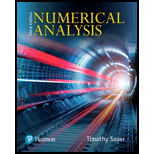Solutions for Numerical Analysis
Problem 1E:
Find the PA=LU factorization (using partial pivoting) of the following matrices: a. [ 1323 ] b. [...Problem 2E:
Find the PA=LU factorization (using partial pivoting) of the following matrices: a. [ 110211111 ] b....Problem 3E:
Solve the system by finding the PA=LU factorization and then carrying out the two-step back...Problem 4E:
Solve the system by finding the PA=LU factorization and then carrying out the two-step back...Problem 5E:
Write down a 55 matrix P such that multiplication of another matrix by P on the left causes rows 2...Problem 6E:
(a) Write down the 44 matrix P such that multiplying a matrix on the left by P causes the second and...Problem 7E:
Change four entries of the leftmost matrix to make the matrix equation correct: [ 0000000000000000...Problem 8E:
Find the PA=LU factorization of the matrix A in Exercise 2.3.15 . What is the largest multiplier lij...Problem 9E:
(a) Find the PA=LU factorization of A=[ 1001110111111111 ] (b) Let A be the nn matrix of the same...Problem 10E:
(a) Assume that A is an nn matrix with entries | aij |1 for 1i, jn . Prove that the matrix U in its...Problem 1SA:
Write a MATLAB program to define the structure matrix A in (2.34). Then, using the MATLAB \ command...Problem 2SA:
Plot the solution from Step 1 against the correct solution y(x)=(f/24EI)x2(x24Lx+6L2), where f=f(x)...Problem 3SA:
Rerun the calculation in Step 1 for n=102k, where k=1,...,11 . Make a table of the errors at x=L for...Problem 4SA:
Add a sinusoidal pile to the beam. This means adding a function of form s(x)=pgsinxLx to the force...Problem 5SA:
Rerun the calculation as in Step 3 for the sinusoidal load. (Be sure to include the weight of the...Problem 6SA:
Now remove the sinusoidal load and add a 70 kg diver to the beam, balancing on the last 20 cm of the...Browse All Chapters of This Textbook
Chapter 0.1 - Evaluating A PolynomialChapter 0.2 - Binary NumbersChapter 0.3 - Floating Point Representation Of Real NumbersChapter 0.4 - Loss Of SignificanceChapter 0.5 - Review Of CalculusChapter 1.1 - The Bisection MethodChapter 1.2 - Fixed-point IterationChapter 1.3 - Limits Of AccuracyChapter 1.4 - Newton’s MethodChapter 1.5 - Root-finding Without Derivatives
Chapter 2.1 - Gaussian EliminationChapter 2.2 - The Lu FactorizationChapter 2.3 - Sources Of ErrorChapter 2.4 - The Pa = Lu FactorizationChapter 2.5 - Iterative MethodsChapter 2.6 - Methods For Symmetric Positive-definite MatricesChapter 2.7 - Nonlinear Systems Of EquationsChapter 3.1 - Data And Interpolating FunctionsChapter 3.2 - Interpolation ErrorChapter 3.3 - Chebyshev InterpolationChapter 3.4 - Cubic SplinesChapter 3.5 - Bézier CurvesChapter 4.1 - Least Squares And The Normal EquationsChapter 4.2 - A Survey Of ModelsChapter 4.3 - Qr FactorizationChapter 4.4 - Generalized Minimum Residual (gmres) MethodChapter 4.5 - Nonlinear Least SquaresChapter 5.1 - Numerical DifferentiationChapter 5.2 - Newton-cotes Formulas For Numerical IntegrationChapter 5.3 - Romberg IntegrationChapter 5.4 - Adaptive QuadratureChapter 5.5 - Gaussian QuadratureChapter 6.1 - Initial Value ProblemsChapter 6.2 - Analysis Of Ivp SolversChapter 6.3 - Systems Of Ordinary Differential EquationsChapter 6.4 - Runge–kutta Methods And ApplicationsChapter 6.5 - Variable Step-size MethodsChapter 6.6 - Implicit Methods And Stiff EquationsChapter 6.7 - Multistep MethodsChapter 7.1 - Shooting MethodChapter 7.2 - Finite Difference MethodsChapter 7.3 - Collocation And The Finite Element MethodChapter 8.1 - Parabolic EquationsChapter 8.2 - Hyperbolic EquationsChapter 8.3 - Elliptic EquationsChapter 8.4 - Nonlinear Partial Differential EquationsChapter 9.1 - Random NumbersChapter 9.2 - Monte Carlo SimulationChapter 9.3 - Discrete And Continuous Brownian MotionChapter 9.4 - Stochastic Differential EquationsChapter 10.1 - The Fourier TransformChapter 10.2 - Trigonometric InterpolationChapter 10.3 - The Fft And Signal ProcessingChapter 11.1 - The Discrete Cosine TransformChapter 11.2 - Two-dimensional Dct And Image CompressionChapter 11.3 - Huffman CodingChapter 11.4 - Modified Dct And Audio CompressionChapter 12.1 - Power Iteration MethodsChapter 12.2 - Qr AlgorithmChapter 12.3 - Singular Value DecompositionChapter 12.4 - Applications Of The SvdChapter 13.1 - Unconstrained Optimization Without DerivativesChapter 13.2 - Unconstrained Optimization With Derivatives
Sample Solutions for this Textbook
We offer sample solutions for Numerical Analysis homework problems. See examples below:
Given information: f(x)=x3−4x+1 Theorem used: Intermediate Value Theorem: If f is a continuous...Given information:Initial guesses x0=1 and x1=2 and equation is (a) x3=2x+2 . Calculation: With the...Chapter 2.7, Problem 1EChapter 3.5, Problem 1EChapter 4.5, Problem 1EChapter 5.5, Problem 1EChapter 6.7, Problem 1EChapter 7.3, Problem 1CPChapter 8.4, Problem 1E
More Editions of This Book
Corresponding editions of this textbook are also available below:
Student Solutions Manual for Numerical Analysis
2nd Edition
ISBN: 9780321783929
Numerical Analysis
2nd Edition
ISBN: 9780321783677
Numerical Analysis, Books A La Carte Edition (2nd Edition)
2nd Edition
ISBN: 9780321816764
EBK NUMERICAL ANALYSIS
3rd Edition
ISBN: 9780134699370
Numerical Analysis
3rd Edition
ISBN: 9780134697376
Numerical Analysis, Books A La Carte Edition (3rd Edition)
3rd Edition
ISBN: 9780134697338
Numerical Analysis
1st Edition
ISBN: 9780321268983
Student Solutions Manual For Numerical Analysis
1st Edition
ISBN: 9780321286864
Related Math Textbooks with Solutions
Still sussing out bartleby
Check out a sample textbook solution.
